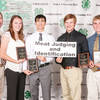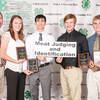

The meat judging program in Llano has had more than its share of success over the years.
The 2016 team qualified for the Western National Roundup to be held in January in Denver, Colo., joining a long line of its predecessors that have qualified for national competitions. In fact, Llano has qualified for a national FFA or 4-H event in 10 of the 16 years that Joe Dan Tarter has been coaching.
“Good kids, good kids,” Tarter said when asked why the program has been able to compete at a high level for such a long time.
The meat judging team competes all across the state and even farther, but what exactly is meat judging?
The competition includes retail identification and placing classes for both FFA and 4-H contests, Tarter said. The 4-H competition includes an oral defense of the placing, while the FFA contest includes yield grading.
There are several components to each part of the competition. Retail identification includes grading cuts that one would see in a store, but with much more detail, Tarter said.
“There are specific names that they have to know almost, and there’s roughly 130 cuts that they have to know,” Tarter said. “And then in the contest itself, depending on what contest it is, there will be 30 or 40 cuts that they have to properly identify. When they do that, they have to name the species – whether it’s beef, pork or lamb. Then the wholesale cut, what part of the body it comes from. The retail name of the cut, and then the proper cookery method. That’s what they have to know on retail ID.”
Tarter said it is imperative to get as many points in retail identification as possible in order to “keep in the ball game” in the competition.
“As a matter of fact, the last two or three times we’ve been out of state, I’ve had three kids that haven’t dropped a point,” he said. “If you can do that, you’re in pretty good shape.”
In the placing classes portion of the competition, there are four exhibits - four beef or pork, and they are placed best to worse.
However, there is a little more to the competition than just placing them. In the 4-H competition, students are required to orally defend their positions on the placings.
“They have to go into a room in front of a judge and tell them why they placed a class the way that they did,” Tarter said.
Grade yield is included in the FFA contest, in which six carcasses are graded on their quality. Each grade is like one placed on meat at a grocery store, only more specific than choice, select or prime.
“We have to do, low choice, average choice, high choice. They have to be more specific,” Tarter said. “They just can’t call it choice. They have to be more accurate than that.”
Yield grading also includes an assigned number that gives the total retail cuts yielded from the carcass, Tarter said.
The FFA competition also includes a food production test that includes questions on things such as microorganisms and food safety.
And the competition also includes a lot of time in the freezer, Tarter said.
There are four members on each meat judging team, and the top three individual scores are counted. The FFA contest allows only one team per school to compete at area, which is the state qualifying event. The 4-H contest allows multiple teams in each contest. The top two teams at state qualify for nationals.
Tarter uses slides to teach students before going to competitions at stock shows and universities in the spring. The teams go to the Fort Worth, San Antonio, Houston and San Angelo stock shows, in addition to practice competitions at Angelo State, Tarleton State and Texas Tech.
“Time in the cooler, practicing, that’s how they learn it,” he said.
It takes a lot of dedication to be involved. The team often leaves for competitions at 5 a.m. on a Saturday morning. Competitions also include hours in large freezers.
“I’ve had kids that go into that first one and they come out, ‘This isn’t for me,’” Tarter said.
The students are in the freezer for about three hours during the contest, and then after a short break outside, they go back into the freezer for another hour or hour and a half so Tarter can go over the contest with them and help them learn from their mistakes.
Tarter moved to Llano in 1995 and coached his first meat judging team at LHS in 1996. He has coached 16 out of the past 20 years, and Llano has qualified for a national contest in 10 of the 16 years that he has coached.
The team won the FFA nationals in 2012 and the 4-H nationals in both 2013 and 2015, Tarter said. Llano has also won the Western National Roundup in Denver four times.
“Llano has always had a very strong judging program over the years,” Tarter said.
It has been stronger at times, depending on the agriculture teacher and in which areas their expertise came from, he said.
Most of the students who join the meat judging team have some type of agriculture background, but some do not. Those who do not have an agriculture background usually get involved after taking a class and deciding to get involved.
Being involved in meat judging can not only help students down the line in the industry, but teaches them much larger skills, Tarter said.
“It’s not just agriculture, it can help them in everything,” he said. “They have to learn decision-making skills and then they have to be able to stand up and defend why they did what they did. Those are two components, decision making and being able to defend the decision that they’ve made are two of the big things they take out of it.
“Plus, teamwork, commitment, just hard work on the kids themselves in order to be prepared to do well.”
Trey Brooks, a 2009 Llano High School graduate, heartily agrees with Tarter’s assessment. Brooks spent three years on the LHS meat judging team, before competing on the meat judging team for three years at Texas A&M University. He was also a collegiate All-American in 2012, which goes to the top eight individual students in the country.
“I use it every day,” said Brooks, who is now a loan officer at Capital Farm Credit in San Saba.
“The ability to get in front of people and talk to them has helped greatly,” Brooks said. “Communication skills, to be able to talk to people and explain why they were placed the way they were. That carries over. I have to talk with clients or write emails to them every day, or people who may become clients.
“Decision making, it helped in the ability to reason. In high school we had to tell the judges why we placed them the way we did. In college, I had to write the reasons. It has helped greatly.”
Brooks said he got involved with the program because he grew up in agriculture.
“I never heard much about meat judging,” he said. “In school I was around ag students and was approached by Joe Dan with the opportunity to get involved, and I did.”
Brooks said his favorite memory from meat judging at LHS was winning the national championship.
“We kicked the tar out of everybody else in the country,” he said.
Out of the top five individuals at the competition that year, four of them were from Llano.
“You sit in this big banquet ballroom and they’re calling out the results. Joe Dan likes to keep his own charts and figure out where everybody is going to finish,” Brooks said. “Everybody is looking at him, waiting to see what he has to say. He put his pencil down and quit after the first two categories.
“‘I don’t have to figure this anymore. We blew everyone away.’”
Brooks said the quality of education he received from Tarter, along with Jamie Osbourn in the county extension office, was a great benefit for both him and other students. They not only helped in the classroom, but used their contacts to allow students to tour different areas of the industry, including a harvest plant and in animal livestock production.
“They went far above and beyond what a lot of people do, and a lot of the opportunities I had, they opened doors to schools and careers and scholarships that wouldn’t have been available otherwise, without meat judging,” Brooks said. “I’m not saying that to toot their horns, but they exposed us to things that we didn’t know and wouldn’t otherwise have been exposed to, and that’s what a teacher is supposed to do. They put us in the position to be successful.”



